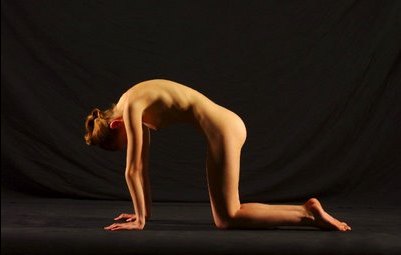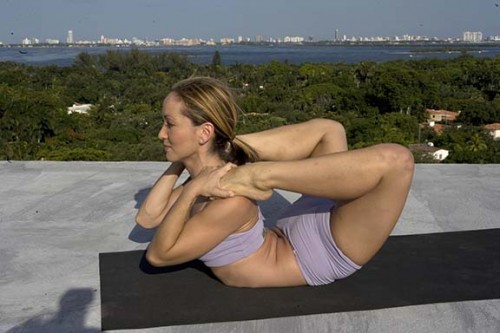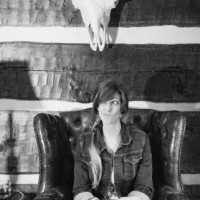(Warning: naughty language ahead!)
The first time I walked into a real yoga studio (not the gym), I was wearing baggy pants and a T-shirt.
I remember being completely embarrassed about my clothes and the fact that I had no idea what we were doing. I also felt incredibly self-conscious about the idea that someday I would probably have to wear spandex.
Fortunately, I was with a good friend, and we had a good teacher. Throughout the practice, she reminded us that the only thing that mattered was what was happening on our mat. Everything else going on in that room was none of our business. I emerged sweaty but happy and excited to go back. I was, though I didn’t realize it at the time, also grateful to have such a safe and supportive environment in which to practice.
When I moved back to Boulder, I had to work hard at the eyes-on-my-own-mat part, because there was some serious business going down in the yoga studio where I had just begun my teacher training.
About 18 months into my practice, I still was unable to lower into or lift out of Chaturanga with any kind of integrity of alignment, at least without looking like I was doing the worm. But apparently I had moved to the land of bionic yogis.
I felt pretty good about my practice when I left Raleigh. I had read books, taken hundreds of classes, even stood on my hands a few times against a wall. But nothing could have prepared me for the straight-up ass kicking I got that first night of training. I felt so embarrassed that I almost cried. Then I ate a burrito, as I would do many more nights for the next 10 weeks.
I was lucky to have good teachers, women and men who understand the evolution that we are presented with in yoga and who know exactly how to coach us through it. When my primary teacher announced that she’d kicked our asses on purpose, I was so relieved. When she told us that the ass kicking was so that she could see where we were in our practices, and that it was nothing for us to judge ourselves on, I could have kissed her.
This reiteration of focus on our personal work set the tone for the bulk of my study and set me up to see my practice for what it is: Mine.
A Personal Focus
It took some work—Boulder yogis are strong, practiced, and gorgeous—but I learned to set my focus internally to the point that most nights I wouldn’t even notice who was there until we were all chatting in the hallway, pulling on our snow boots.
Our teachers were so good at keeping us focused on the personal work of the practice that, at one point in a three-legged down dog, I thought to myself, “Whoa. This feels amazing. My hamstrings are so flexible! My leg must be so high up there.”
Then I looked in the mirror and saw my right leg hanging awkwardly not two feet from the ground. I was devastated and entered into an unhealthy relationship with the one mirror in the room. I was scattered. Lost in that damn mirror. But it felt so good. Why did it look like shit?
Back to my mat I went. I faced away from the stupid mirror. I focused on the muscles being used, how the poses felt to me, how they were different than the last time I’d stepped in. What were the lessons available in a given night’s practice?
I wrote and practiced and wrote and practiced, and this is what yoga became for me—a place to explore the things that I am capable of, both on and off the mat.
As my physical strength grew, so did my mental and emotional strength as I confronted some difficult times in my personal life. Yoga was coming at me hard and fast, and it was a lot to take, but I had a safe space, and I was conscious of respecting my edges and moving with what felt comfortable to me.
One night, I randomly began doubting my path, and I looked over at the guy next to me. He effortlessly floated from down dog into a pike into a handstand into a forward fold. I felt like a Dodo bird just trying to get off the ground. I was distraught. I tried to stay in my body, I tried to think of how far I’d come, but I was at a loss. I told myself: “I’ll never get there. I just need to accept it. I’ll always be a baby giraffe on ice skates.”
As if on cue, my teacher said: “Stay focused on your work. Do not covet thy neighbors asana.”
We laugh.
I thought: “She’s right, both about the ass joke and also not wishing you could do whatever it is your neighbor is doing.”
When it came time to sit cross-legged, the flying man’s knees were up around his ears. Mine were flat on the floor. My hips were open, yet I was envying his ability to stand on his hands. We all have our strengths, things that feel tight and places where we are fluid.
None of us ever comes to the mat with the same work to do. Our biography becomes our biology, and everything that we’ve been through—every break-up, fitful night, success—has made us the people we are and determined what the bodies we live are capable of.
There’s no going back. We are a perfect combination of our successes and failures, our loves and losses, our wins and missteps. We can only be who we are, and, to quote Judy Garland, being a first rate version of yourself is much better than being a second rate version of someone else.
Form and Function in Yoga
I’ve been in it for awhile, this mindset that yoga is a way to develop and respect our strength, a place to confront our past and bring the best parts of ourselves into our most current, ever-evolving incarnation, not worrying about the next thing, being in the flow, staying with the movement, at once in and of only ourselves.
I have so much respect for this practice, for my teachers, for their dedication to the function of the practice over the form. The form is a goal, something to work toward, something against which we can measure our progress, but which also moves with us, always changing depending on what we’ve brought with us to the mat.
The function, however, we can play with everyday. The function of a pose is always accessible, ready for us to ask how does it feel? And we learn to compare ourselves only to ourselves. Where am I today relative to where I was yesterday? What’s that about? What can I do in this moment to learn from my experience?
So that’s where I am after almost five years of consistent yoga practice, hundreds of hours of training, thousands of classes.
Yoga Stripped Bare
When I came across an article on a yoga studio that offers “Bold & Naked” yoga classes with the claim that “practicing yoga naked frees you from negative feelings about your body and allows (you) to be more accepting and deeper connected with yourself and the world around you,” while stating that it’s completely non-sexual, I got all kinds of hot and bothered.
First of all, doing yoga naked with a bunch of other naked people isn’t going to free you from shit, except maybe wondering whether or not you bought the see-through lulus. And getting naked, arbitrarily I might argue, with people you don’t know won’t make you feel better about your body.
 Doing the work, on your mat and in your heart, is going to make you feel better about your body. Learning to value your body for its strength is going to get you past those negative feelings. Finding the edges within your own practice, pushing them, exploring the space you create, retreating from them and delighting in the ease you find—this will allow you to be more accepting and deeply connected with yourself and the world around you.
Doing the work, on your mat and in your heart, is going to make you feel better about your body. Learning to value your body for its strength is going to get you past those negative feelings. Finding the edges within your own practice, pushing them, exploring the space you create, retreating from them and delighting in the ease you find—this will allow you to be more accepting and deeply connected with yourself and the world around you.
When we start to see our bodies as our homes and we witness firsthand the interrelatedness of our choices, we recognize that how we treat our bodies directly affects how they treat us, then we will find the acceptance that we are looking for.
But if we go into a room full of strangers and take off all our clothes and expect for anything to happen other than maybe we get desensitized to public nudity, we’re fooling ourselves. To the girl who claimed: “When we’re naked, it’s like we’re all the same”: Listen sister, this isn’t a kids’ book where all the people are shaped like fruit. While the photos in the article show people who are all relatively fit and attractive, I can’t think of anything more different than a bunch of naked people standing around.
I’m six feet tall with red hair (yes, there), skinny arms and serious booty. My best friend has a massive scar across his chest from an operation. One of the women I practice with regularly just had a double mastectomy, and I know lots of people who’ve come to yoga to help get through eating disorders, alcoholism and cancer.
How does looking at other people naked make me feel better about myself? If I’m worked up about someone in class who has nicer yoga pants than I, do you really expect me to get past the chick with Giselle’s ass on the mat next to me when I’ve had cellulite since I was 16?
Getting Personal
Those issues are still there, clothes or not. The practice is about kindness—toward ourselves and toward others—and moving at our own pace. Maybe seeing that other people have imperfections, too, might make us feel better, but we can’t just show up and expect miracles to happen because we get naked.
We have to do the work. We have to show up and make miracles happen from the inside out.
While I’ve never shown my asana, so to speak, in class, and nor do I intend to, I know that I’ve had some seriously vulnerable moments, and I’ve been able to expose things that are far more private than my backside because I felt safe.
I wasn’t worried if someone was looking at my boobs. I wasn’t wondering if my Britney would stick to my mat. I was practicing in a way that made sense to me, with teachers who were willing to help us confront the mess that yoga sometimes makes of our lives, and as a part of a community that would catch me if I ever fell.
That is how yoga helped me get over my body issues. That is how I learned to love myself, to respect my strength and cherish this bod that’s carried me around through thick and thin. That is how I did the work. Every day.
And to the studio owner who said that practicing naked is “about being comfortable in your own skin and the amazing confidence that comes with it,” I say: “That’s earned, friend.”
Yoga is about the freedom that comes from baring your soul, not your skin. It takes time, and anyone who claims differently is selling something.
Love elephant and want to go steady?
Sign up for our (curated) daily and weekly newsletters!
Apprentice Editor: Pamela Mooman / Editor: Jenna Penielle Lyons
Photos: elephant journal archives







Read 12 comments and reply